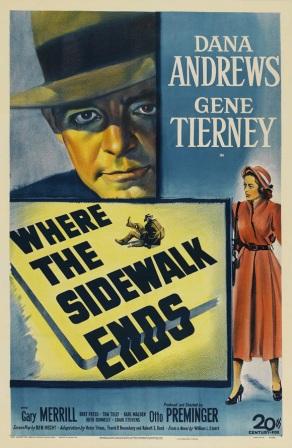“That’s a fancy way of trying to frame somebody—getting yourself knocked off. A guy’s gotta be outta his head for that. I didn’t know a guy could hate that much—not even you.”— Tommy Scalise to Dixon
After the success of Laura in 1944, the four main artists were reunited, possibly accidentally, probably by design. Director Otto Preminger, cinematographer Joseph LaShelle and stars Dana Andrews and Gene Tierney came together again in 1950 for Where the Sidewalk Ends. The resulting film is not as great as Laura, practically an entity unto itself, a milestone of sorts, one of the great noir films. Nor is the pairing of the two leading stars as dynamic or romantic as in their previous appearance.
Even Laura isn’t the first pairing of Andrews and Tierney. They appear together in Tobacco Road (1941), though they spend hardly five minutes of shared screen time, since minor star Charley Grapewin is the top-billed star. In Belle Starr (1941) the pair become married, Tierney disastrously miscast as a Western outlaw. And after Laura, they appear together one last time, as man and wife in The Iron Curtain (1948), a post-World War II espionage thriller, now about the new threat, communism.
Although with a far less impressive score than that for Laura—the composer is, after all, the great David Raksin—the music for Where the Sidewalk Ends is by second-stringer Cyril Mockridge.
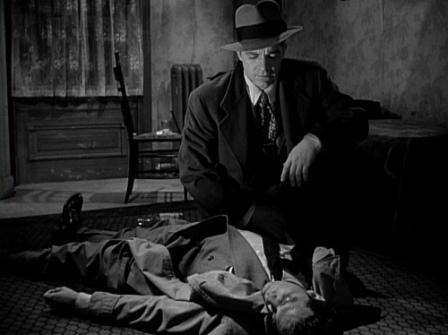 The musical mood of the film, however, is saved by a reuse of Alfred Newman’s “Street Scene,” which is introduced immediately by a man whistling as he navigates a sidewalk, the credits uniquely written on the cement—only for the two major stars’ names and the title; the remaining credits are given against policemen in a patrolling squad car. It is this Newman music, in its guises and variations, which mimics the twists and turns of all the suspense, deception and malice that surround the film’s characters, residents of the less fashionable streets, alleys and slums of New York City.
The musical mood of the film, however, is saved by a reuse of Alfred Newman’s “Street Scene,” which is introduced immediately by a man whistling as he navigates a sidewalk, the credits uniquely written on the cement—only for the two major stars’ names and the title; the remaining credits are given against policemen in a patrolling squad car. It is this Newman music, in its guises and variations, which mimics the twists and turns of all the suspense, deception and malice that surround the film’s characters, residents of the less fashionable streets, alleys and slums of New York City.
Newman’s tune has quite a history, probably 20th Century-Fox’s most famous. It first appears in 1931 in Street Scene, starring Sylvia Sidney and Estelle Taylor, then in I Wake up Screaming (1941), The Dark Corner (1946), Kiss of Death (1947)—the last three film noirs. In two breaks from that genre came My Friend Irma (1949) and, most famously, How to Marry a Millionaire (1951). In the last, before the credits appear, Newman conducts a filmed orchestra in an expanded concert version of “Street Scene.”
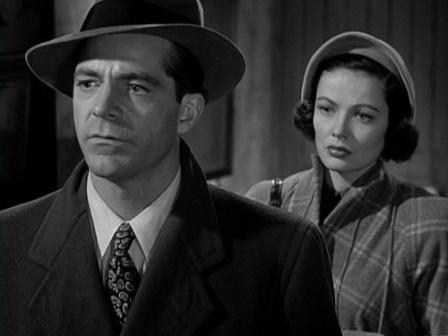 As in Laura, the first voice heard in Sidewalk—discounting the police radio chatter in the squad car—is the killer’s, though not intended as a clue. And certainly in Laura, Clifton Webb’s narrating the story tends to make his character, Waldo Lydecker, the least suspected of the suspects.
As in Laura, the first voice heard in Sidewalk—discounting the police radio chatter in the squad car—is the killer’s, though not intended as a clue. And certainly in Laura, Clifton Webb’s narrating the story tends to make his character, Waldo Lydecker, the least suspected of the suspects.
In the first major scene in Sidewalk, for his rough-handling of criminals, detective Mark Dixon (Andrews) is demoted and criticized by Inspector Nicholas Foley (Robert F. Simon). Simon, here making his screen début, and discourteously uncredited, can be seen in myriad roles, best on television, living on in M*A*S*H reruns as befuddled General Maynard M. Mitchell.
Dixon, in fact, treats drunken gambler Ken Paine (Craig Stevens) maliciously, and, in self-defense, accidentally kills him. The detective then dumps the body in the river. Later assigned to find the killer, Dixon attempts to frame well known gangster Tommy Scalise (Gary Merrill) for the murder. Cab driver Jiggs Taylor (Tom Tully, Commander DeVriess in The Caine Mutiny, 1954) somehow ends up under suspicion.
Dixon becomes further entangled. First, he is attracted to Taylor’s daughter Morgan (Tierney), a fashion designer and Paine’s estranged wife. Then, in trying to do a good deed and clear Taylor for Morgan’s sake, he makes matters worse for himself.
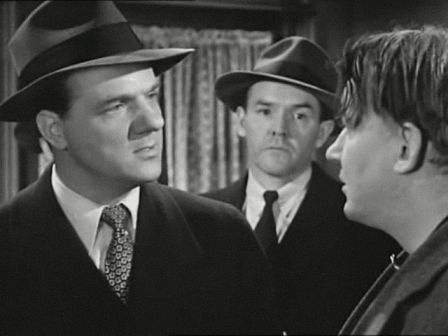 Foley and the newly promoted Lieutenant Thomas (Karl Malden) are convinced that Taylor is the killer, and when Dixon, in renewing his attempts to frame Scalise, is confronted by the gangster, he is wounded in a shootout. The police arrive and arrest Scalise and Taylor is cleared of murder. In a turnaround, Dixon confesses to the Paine murder.
Foley and the newly promoted Lieutenant Thomas (Karl Malden) are convinced that Taylor is the killer, and when Dixon, in renewing his attempts to frame Scalise, is confronted by the gangster, he is wounded in a shootout. The police arrive and arrest Scalise and Taylor is cleared of murder. In a turnaround, Dixon confesses to the Paine murder.
Like most film noirs, Sidewalk is more complicated than suggested by this brief synopsis, which also omits a few of the more important secondary characters. Along with Tom Tully, Ruth Donnelly practically steals the show as owner of Martha’s hole-in-the-wall cafe. Some of the other actors include Bert Freed as Dixon’s detective partner, Neville Brand as a Scalise hood, fashion designer Oleg Cassini (then Tierney’s husband) playing himself and Harry von Zell (the announcer on the George Burns and Gracie Allen Show) as another murder victim.
As if a carryover from Laura, Dana Andrews is still the hard-nosed, unemotional detective, and seems to be, for a while, repeating his Mark McPherson role from Laura. His naturally inflexible facial features make this emotional drought easy, but in Sidewalk Ben Hecht’s tight screenplay provides him wider psychological opportunities. He dutifully takes advantage of the script, for here he is struggling to separate his bad side from his good one, with occasional poses, demeanors and neuroses, even a physical disguise.
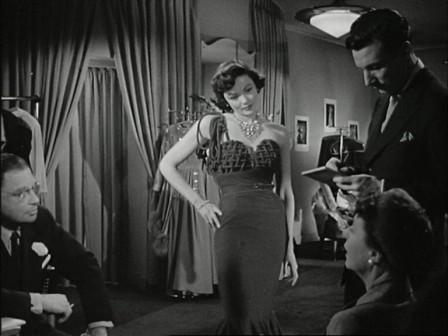 Gene Tierney, by contrast, has less to do. In Laura she is top-billed above Andrews; here she is second-billed below him. She has less screen time, too, and far fewer scenes with her co-star.
Gene Tierney, by contrast, has less to do. In Laura she is top-billed above Andrews; here she is second-billed below him. She has less screen time, too, and far fewer scenes with her co-star.
In his commentary accompanying the DVD, Eddie Muller has some unflattering remarks about 20th Century-Fox’s “porcelain doll superstar” that somehow awakened my own suspicions regarding her. With “I’ve never quite grasped Gene Tierney’s appeal,” he begins his unofficial image assassination.
Despite a “face made for close-ups” and her skill at “guileless innocence,” Muller observes that “she isn’t remotely close . . . to Bette Davis, Barbara Stanwyck or Ida Lupino” in acting ability, and has “none of the sex appeal of an Ava Gardner, a Rita Hayworth or a Linda Darnell.” And the fascination, at the time, with this sometimes “stiff manikin”? Muller believes the public saw her as “a fairy tale princess,” a kind of pre-Grace Kelly, he adds. As for the last, I would staunchly disagree: Tierney has none of the smoldering, under-the-surface sexual allure of Grace Kelly.
[embedyt] https://www.youtube.com/watch?v=mhNGCWgQD1g[/embedyt]
